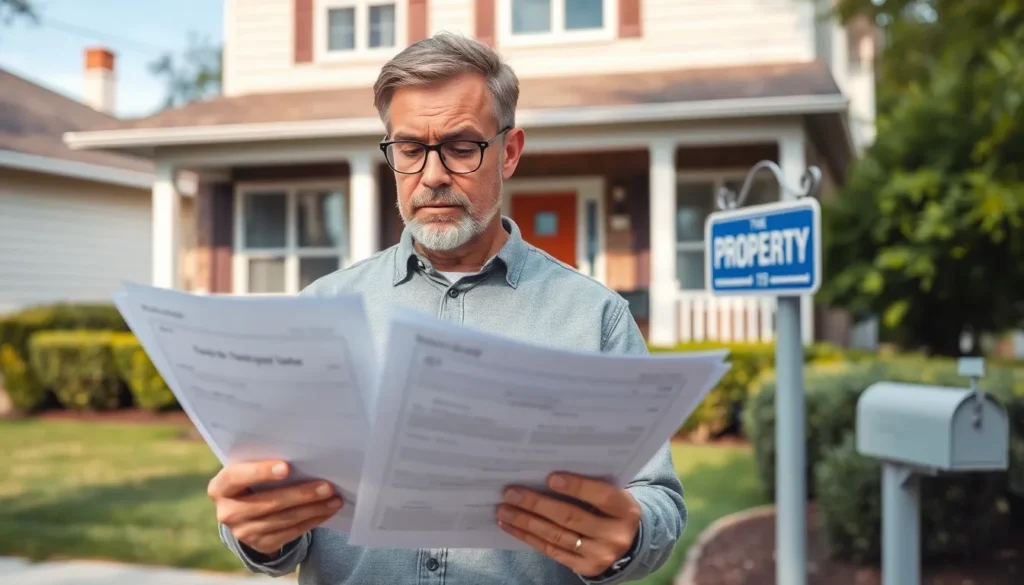Table of Contents
ToggleFlipping houses for profit isn’t just a trend; it’s a thrilling adventure that can turn a fixer-upper into a cash cow faster than you can say “renovation reality show.” Imagine transforming a drab space into someone’s dream home while padding your wallet at the same time. It’s like being a superhero, but instead of a cape, you wield a paintbrush and a hammer.
But before diving into the world of real estate flips, it’s crucial to understand the ins and outs of this lucrative market. With the right strategy and a sprinkle of creativity, anyone can master the art of flipping houses. So grab your toolbelt and let’s explore how to turn those neglected properties into gold mines, all while avoiding the pitfalls that could turn your dream into a nightmare.
Overview of Flipping Houses for Profit
Flipping houses for profit involves buying undervalued or distressed properties and selling them at a profit after making improvements. Investors often seek properties in desirable neighborhoods, ensuring a better market for resale. This method allows individuals to capitalize on real estate trends and market demand.
Real estate market understanding is crucial. Investors analyze local market conditions to identify which areas show potential for growth. Seasonal fluctuations also play a role in timing purchases and sales. Strategies include researching comparable sales, assessing renovation costs, and setting a realistic resale goal.
The process typically consists of several steps. First, investors secure financing, which may include personal savings, bank loans, or private investors. Next, they find properties through listings, foreclosures, or auctions. Afterward, conducting inspections is important to unearth hidden issues that could affect renovation costs or timelines.
Effective renovations focus on appealing to target buyers. Remodeling kitchens and bathrooms generally yields higher returns. Upgrading curb appeal through landscaping or exterior work enhances buyer interest. Budgeting for unexpected expenses is vital, as overages can erode profit margins.
Networking with real estate professionals can facilitate smoother transactions. They can provide insights about local market trends and renovation best practices. Partnerships with contractors can streamline the renovation process and improve efficiency.
Success in flipping houses requires a proactive approach. Plenty of research and planning leads to successful outcomes. Committing time and resources typically results in more significant profits. With the right strategy and dedication, investors can navigate challenges and turn a profit in house flipping ventures.
Benefits of Flipping Houses

Flipping houses offers numerous advantages for investors. Profit potential remains one of the most compelling reasons to enter this market.
Financial Gains
Financial returns from flipping houses can be substantial. Many investors achieve profit margins ranging from 20% to 30% on their initial investment. Successful flips often involve purchasing properties at a low cost and increasing their market value through renovations. Investors can sell properties quickly, sometimes within months, allowing them to reinvest their earnings into more projects. Identifying up-and-coming neighborhoods can significantly enhance profit potential. Lower purchase prices coupled with rising property values can lead to impressive returns on their investment.
Skill Development
Flipping houses enhances various skills crucial for success. An investor hones negotiation abilities when purchasing properties and dealing with contractors. Knowledge of market trends and property evaluation improves through experience. Renovation skills develop as investors manage projects and work with professionals in trades such as plumbing and carpentry. Time management becomes vital, as coordinating schedules and deadlines directly impacts profitability. Financial literacy increases, too, as investors learn to budget for renovations and unexpected costs. Each flipped house contributes to a growing skill set valuable for future real estate endeavors.
Risks Involved in Flipping Houses
Flipping houses presents several risks that investors must navigate carefully to maintain profitability. Understanding these risks can enhance decision-making in the house flipping process.
Market Fluctuations
Market fluctuations can significantly impact property values. Changes in local demand and supply directly affect resale opportunities. In some cases, a declining neighborhood may lead to unsold properties. Timing purchases to align with market trends is crucial. Investors examining market data can better predict potential downturns and capitalize during peak seasons. By keeping a pulse on community developments and economic indicators, one can mitigate risks tied to fluctuations.
Cost Overruns
Cost overruns often derail budgets and threaten profit margins. Unexpected repairs can arise during renovations, leading to increased expenses. Investors regularly underestimate project costs, including materials and labor. Maintaining a contingency fund can safeguard against these financial surprises. By meticulously planning and budgeting—including the potential for higher costs—investors can preserve their returns. Collaborating with experienced contractors helps provide accurate estimates and efficient management of renovation projects.
Steps to Successfully Flip a House
Flipping houses involves several crucial steps that can maximize profits and streamline the process. Understanding how to navigate each component can significantly enhance overall success.
Finding the Right Property
Investors should focus on distressed houses in desirable neighborhoods to ensure strong resale potential. Research local markets to identify undervalued properties that may offer significant upside. Utilizing multiple channels like real estate listings auctions and foreclosure sales can uncover hidden gems. Analyzing key factors such as location amenities and comparable sales helps pinpoint the best property options. Networking with real estate agents can provide valuable insights into upcoming listings that might not be widely advertised.
Financing Your Flip
Securing financing for a house flip requires careful planning. Investors often turn to hard money loans which offer quick funding for renovations. Traditional mortgages may delay the process and are usually less favorable for flipping. Establishing a budget that includes purchase costs renovation expenses and unexpected repairs is crucial. It’s wise to have a contingency fund for unforeseen expenditures which are common during renovations. Discussing financing options with experienced professionals can provide clarity and help investors make informed choices.
Renovation Strategies
Focusing on key renovations enhances property appeal and increases market value. Emphasizing kitchen and bathroom upgrades often yields the highest returns, as these spaces greatly influence buyer perception. Prioritizing curb appeal through landscaping and exterior improvements captures potential buyers’ interest before they enter the home. Keeping renovations in line with neighborhood standards ensures that changes resonate with target markets. Collaborating with reliable contractors can lead to efficient project management which minimizes delays and keeps costs in check. Maintaining clear communication with the team throughout the renovation process helps stay on track.
Tips for Maximizing Profit
Maximizing profit in house flipping requires strategic planning and execution. Understanding market trends and effective marketing techniques proves essential for achieving the best results.
Understanding Your Market
Familiarity with local real estate conditions plays a pivotal role in successful flips. Investors should analyze recent sales, assessing property values and trends in neighborhoods. Recognizing seasonal patterns can also influence buying and selling strategies. Pay attention to demographic shifts that may signal growth areas. Monitoring competition helps in pricing properties competitively while ensuring desirable renovations. Engaging with local real estate professionals offers valuable insights into market dynamics. Gathering data on average days on market equips investors to make informed decisions.
Effective Marketing Techniques
Attracting potential buyers involves utilizing various marketing strategies. Crafting high-quality listings with professional photos captivates audiences and showcases properties effectively. Social media platforms provide a powerful avenue for promoting listings. Developing an online presence can significantly enhance visibility. Consider staging properties to highlight key features and create emotional connections. Hosting open houses allows potential buyers to experience the space firsthand. Additionally, email marketing lists can target specific demographics, driving traffic to properties for sale. Building relationships with local real estate agents can amplify marketing efforts and reach a broader audience.
Flipping houses can be a rewarding venture for those willing to invest time and effort. By understanding the market and employing smart strategies, investors can turn neglected properties into profitable assets. The journey requires a blend of creativity, financial acumen, and a solid network of professionals.
Navigating the risks is essential for maintaining profitability. With careful planning and a clear budget, investors can mitigate unexpected costs and make informed decisions. Each successful project not only enhances financial returns but also builds valuable skills for future investments.
Ultimately, house flipping offers a unique opportunity for personal growth and financial success. With the right approach, anyone can thrive in this dynamic real estate landscape.







